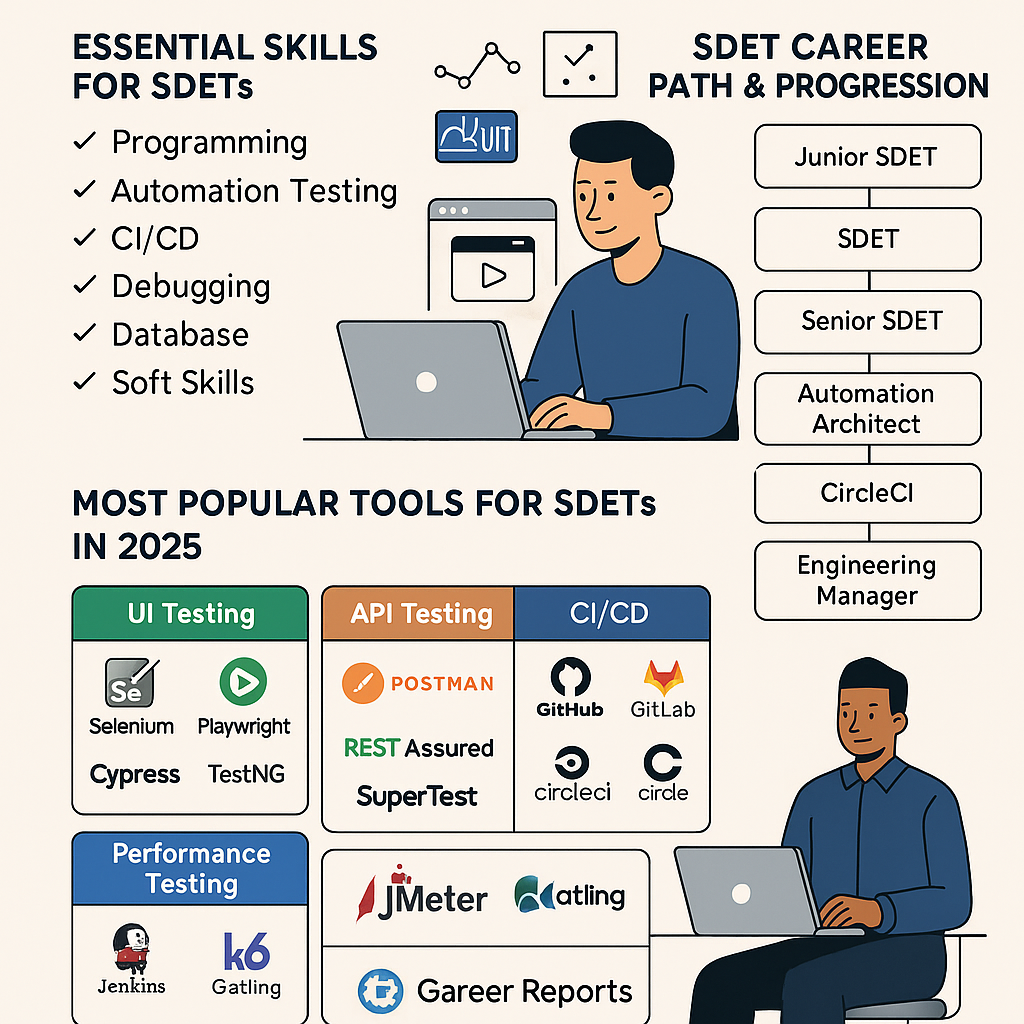
Introduction
The role of the Software Development Engineer in Test (SDET) has become one of the most dynamic and in-demand careers in tech. With the rise of DevOps, continuous testing, and automated delivery, companies are now seeking professionals who can both write code and ensure its quality. If you’re exploring a future-proof career that blends software engineering with quality assurance, SDET might be the perfect choice.
Who is an SDET?
An SDET is a professional who is proficient in both software development and testing. Unlike traditional QA engineers who primarily focus on manual testing, SDETs design, develop, and maintain automation frameworks, write code, build CI/CD pipelines, and contribute to the software’s testability and scalability from day one.
They are software engineers at heart but with a passion for ensuring product quality.
Why Choose an SDET Career in 2025?
- 🚀 High demand in Agile and DevOps environments
- 💰 Lucrative salaries with full-stack skill expectations
- 🌎 Remote and global work opportunities
- 📈 Career progression to leadership and architect roles
- 🧠 Balance of creativity and logical problem-solving
As companies ship faster, they need testing to keep up. That’s where SDETs shine.
Key Responsibilities of an SDET
- Building and maintaining automated test frameworks
- Creating test plans and test cases
- Writing automation scripts for UI, API, and performance tests
- Collaborating with developers in agile teams
- Maintaining test data, mocks, and test environments
- Ensuring CI/CD test pipelines are stable and efficient
Essential Skills for SDETs
- Programming: Proficiency in Java, Python, or JavaScript
- Test Automation: Selenium, Playwright, Cypress
- CI/CD: Jenkins, GitHub Actions
- API Testing: Postman, REST Assured
- Database: SQL, NoSQL (MongoDB, PostgreSQL)
- Version Control: Git, GitHub
- Debugging: Reading logs, stack traces
- Soft Skills: Communication, documentation, teamwork
Most Popular Tools for SDETs in 2025
| Category | Tools |
|---|---|
| UI Testing | Selenium, Playwright, Cypress |
| API Testing | Postman, REST Assured, SuperTest |
| CI/CD Integration | Jenkins, GitLab CI, CircleCI, GitHub Actions |
| Test Management | TestRail, Xray, Zephyr |
| Performance Testing | JMeter, k6, Gatling |
| Reporting | Allure, Extent Reports, ReportPortal |
Automation Frameworks Every SDET Must Know
- Selenium WebDriver – Legacy but still widely used.
- Playwright – For modern, multi-browser E2E testing.
- Cypress – Easy-to-use framework focused on frontend testing.
- TestNG / JUnit – Popular in Java-based test suites.
- Cucumber (BDD) – For behavior-driven testing using Gherkin syntax.
Programming Languages for SDETs
- Java – Most common in large enterprises and TestNG environments.
- Python – Ideal for API testing and quick prototyping.
- JavaScript/TypeScript – Dominates frontend automation (Cypress, Playwright).
- C# – Used in .NET environments (with NUnit or MSTest).
Version Control and Collaboration Tools
- Git/GitHub – For source control and pull requests.
- Bitbucket/GitLab – Alternate version control with integrated CI/CD.
- JIRA – Managing test cases and bugs in Agile workflows.
Continuous Integration Tools
Automate test execution with:
- Jenkins – Widely adopted open-source tool.
- GitHub Actions – Modern and easy-to-integrate workflows.
- GitLab CI – Built-in CI/CD with GitLab projects.
- CircleCI – Cloud-native CI with fast builds.
Database and API Testing Tools
- Postman – Popular GUI for testing REST APIs.
- REST Assured – Java-based library for automated API tests.
- SQL – Must-know language for querying databases during validation.
- DBUnit – For testing database-driven apps.
Performance and Load Testing Tools
- Apache JMeter – Classic tool for simulating user loads.
- k6 – Developer-friendly, scriptable load testing.
- Gatling – High-performance tool, great for real-time analytics.
SDET Career Path & Progression
| Level | Role |
|---|---|
| Entry-Level | Junior QA / Automation Tester |
| Mid-Level | SDET / Test Automation Engineer |
| Senior-Level | Sr. SDET / QA Lead |
| Advanced | Automation Architect |
| Executive | QA Manager / Director of QA |
With experience, SDETs can also transition into DevOps, Product, or Engineering Leadership roles.
Certifications for SDETs
- ISTQB Foundation Level
- Certified Selenium Professional
- Certified Agile Tester
- AWS Certified Cloud Practitioner
- Microsoft Azure Fundamentals
Top Industries Hiring SDETs in 2025
- FinTech – Secure, scalable apps need rigorous testing.
- Healthcare – Compliance and reliability are mission-critical.
- eCommerce – User experience is everything.
- EdTech – Scaling educational platforms with automation.
- AI & SaaS Startups – Fast development needs automated coverage.
Freelancing and Remote Work as an SDET
Thanks to tools like GitHub, Jira, and Slack, remote SDET jobs are booming. Freelancers can find contract work on platforms like Upwork, Toptal, and Fiverr, often commanding premium rates with automation skills.
Conclusion
The SDET role is more than just automation—it’s a fusion of development, quality, and delivery excellence. Whether you’re a developer transitioning into QA, or a manual tester upskilling into automation, now is the best time to pursue a career as an SDET.
FAQs
- What’s the difference between QA and SDET?
QA focuses on testing manually, while SDETs write code and build automated frameworks. - Is coding mandatory for SDET roles?
Yes, strong coding skills are essential for automation and scripting. - Which is the best language for SDET?
Java is widely used, but Python and JavaScript are growing in popularity. - Do SDETs only write tests?
No. SDETs also architect test systems, integrate CI/CD, and ensure test data and infrastructure are robust. - Are SDET jobs remote-friendly?
Absolutely. Many companies offer full-remote and freelance SDET opportunities. - How to become an SDET with no experience?
Learn a programming language, master an automation tool, build a GitHub portfolio, and start applying!